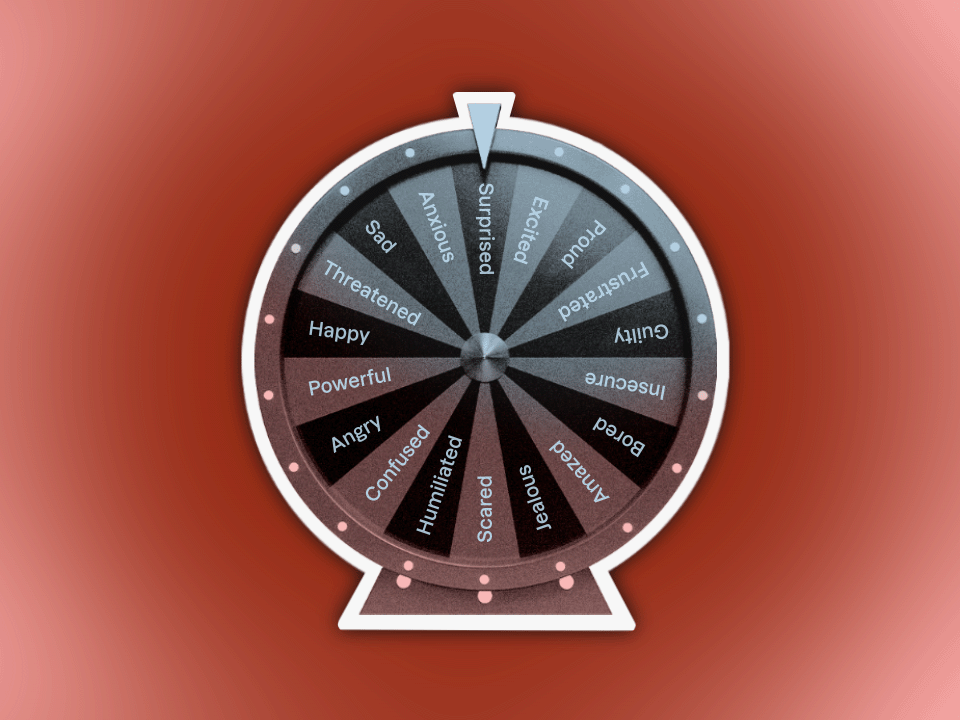How to Get to the Bottom of What You’re Feeling—Without a Therapist
We’re all a little (or a lot) confused sometimes.
Emotions are messy. Maybe you’re mid-breakup with a person, apartment, or job and the whole thing started off pretty sad, but then...BAM! It's like someone threw a +4 UNO card at you, and now you’re picking up extra feelings that complicate what you thought you were feeling in the first place. Or maybe you just wake up in a meh mood for no apparent reason.
Whatever’s happening in your life, it’s natural to feel detached from or confused by emotions since many of us were taught to override, ignore, or push through feelings from an early age, says licensed clinical psychologist Ayanna Abrams, PsyD. So if you’ve gotten used to shoving down sadness, for instance, it would make sense for you to feel confused about what’s going on when it does bubble up.
Then there’s the fact that feeling more than one emotion at a time is a thing (a thing a lot of us are just finding out), says Dr. Abrams. In the case of a breakup, you might be sad that it’s over but also relieved and excited about living a solo life—and a little intimidated by starting to date again. So! Many! Feelings! It’s easy to see how all of those layers make identifying your current emotional state a damn challenge.
Despite the many obstacles to figuring out your feels, making the time to name what’s coming up for you is worth it, says therapist Luis Merced, LMHC. Once you know what you’re feeling, you can decide what you want to do with those emotions, he says. That could look like talking to a friend about what's making you angry or canceling plans to sit with your sadness rather than ignoring it. At the same time, Dr. Abrams says, being more aware of your feelings can help you detect how they’re impacting others. For example, once you realize that you’re mad, you might notice the urge to yell or make passive aggressive comments. That awareness can help you course correct before you snap.
Finally, whether you do something with your feelings or not, just identifying them can make them less intense, Merced adds.
Because most of us are not very good at the whole name-that-feeling game, here’s how you can get to the bottom of your feelings by channeling your creative side, talking to others, and examining your thoughts. Choose your own feeling-finding adventure.
1. Spend some time with the feelings wheel.
A feelings wheel, or emotion wheel, is a visual tool that looks like a giant circle divided up into different feelings. Therapists often use it to help their clients pinpoint what they’re feeling. Since feelings are so complex, there are many versions of this thing—but they are super helpful.
Most of the time, a feelings wheel has easy-to-identify emotions (like sad, happy, or fearful) at the center. Those feelings are broken down into more specific ones as you move toward the outside of the wheel (like lonely, proud, and insecure).
These wheels are a great way to expand your emotional vocab when you aren’t sure what you’re feeling because you can easily identify the big emotions at the center of the wheel, and then work your way out to pinpoint a more specific feeling that you hadn’t thought of. For example, you might start off thinking that you’re sad, but realize after looking at the wheel that maybe it’s more like depressed (or vice versa). By using the wheel, you’re able to see how all of these feelings could be connected.
You can start from the center and work your way out or just wing it to find any emotions that match up with how you might be feeling right now. And it’s more than OK to pick out multiple emotions at the same time—even if they seem contradictory. We really have this “whole rainbow of emotions where they are sometimes conflicting and competing,” says Merced.
Here are a couple of wheels you can give for a spin:
- The Feelings Wheel from Gloria Willcox, PhD. Here, there are six feelings at the center—mad, scared, sad, powerful, joyful, and peaceful—separated by different colors, and the emotions get more specific as you move away from the center based on what could be behind those emotions.
- The Wheel of Emotions by Robert Plutchik, PhD. Here, there are eight emotions toward the center—trust, joy, surprise, fear, sadness, anticipation, anger, and disgust—segmented off into the shape of a flower. (Yay for creativity!) In the very middle, you’ll find an intense version of each, and as you move outward, each emotion becomes less intense.
2. Look for patterns in your thinking.
Jot down the things floating through your brain throughout the day (or the ones you can remember since we have so, so many of them) to track any consistent themes, Dr. Abrams suggests. It might turn out that you think about last week’s fight with your mom way more than you realized. This can help you understand how you’re feeling—annoyed, mad, frustrated, whatever—and how those feelings might be influencing your life, she notes. If that argument with your mom keeps coming up, is that pointing to some internal guilt?
JFYI, thoughts can have a ton of feelings attached to them, and sometimes we have weird thoughts for no reason at all (see intrusive thoughts). That said, this thought auditing exercise can give you a general sense of what’s going on with your emotions.
3. Do a lil body scan.
This mindfulness practice gets you out of your head and into your body, making it a great barometer of what you’re feeling, says Merced. Start by sitting or laying down in a quiet space (ideally without your phone), then focus your attention on the top of your head. From there, slowly shift your focus down your body until you reach your toes. See if any sensations pop up that can indicate what’s going on for you emotionally. For example, if you notice butterflies in your stomach, that can indicate anxiety or excitement. If you have a ton of muscle tension in your shoulders, that might equal serious stress.
4. Do something artistic.
Art often lets us connect to emotions like fear, shame, anger, and passion more easily than words because we tend to feel like it doesn’t need to be as filtered or censored, says art therapist Marygrace Berberian, PhD, LCAT, LCSW, the director of New York University’s Graduate Art Therapy Program. So set aside time to free-draw or free-paint or free-create based on what feels right to you in the moment—and try not to overthink it.
Once you’re finished, spend a few minutes, an hour, or however long you’ve got with your creation. Take a look at it in a non-judgmental way to see if you can gather any intel on your emotional state. Here are some things Dr. Berberian says you can ask yourself: What would my artwork say back to me? Are there any doodles or symbols that show up over and over, and why do I think they’re so prevalent? Does my art remind me of anything in my life (a dream, thoughts, something else)? How would I describe what I’ve made?
You can also assess the medium you chose. It’s definitely possible that the type of art you made (with clay, pencil drawing, or knitting) says something about what you need in this moment, says Dr. Berberian. If you chose to knit or crochet, which takes a lot of repetition, you could be craving a sense of control to soothe stress or overwhelm, she suggests.
5. Play a new song.
Paying attention to how you react to a song can help you get a better understanding of what you’re feeling in real time, says music therapist Allison Terrell, MMT, MT-BC, adjunct assistant professor of music therapy at Shenandoah University.
Jump on your music platform of choice and find a song you haven’t heard before or one that doesn’t remind you of a specific period, place, or person (so not your go-to pregame jam from college), suggests Terrell. Press play and see what comes up for you. Maybe you listen to Adele’s “Easy On Me,” and you feel longing or loneliness come through because you relate to the lyrics, she says. If you don’t respond at all, or don't like the song, that might tell you something too, she notes. Ask yourself why this isn’t resonating with you right now, and try to find a song that does.
6. Ask people you trust how you’re acting.
How you behave can be a good indicator of what you’re feeling, even if you’re consciously or subconsciously trying to hide those emotions, Merced explains. That’s actually a big piece of the theory behind cognitive behavioral therapy (CBT), which suggests that thoughts, feelings, and behaviors are all connected.
So getting the perspective of someone you have a solid relationship with when you’re confused about your feelings can give you an objective(ish) look at your behavior and what that says about your emotions. Start by telling them that you’re trying to sort through your feelings, and then ask them something like, “How’ve I seemed lately?” or “How’ve I been acting?” Merced says. Do they get the sense that you’re worried? Do they think you’re easily annoyed? The conversation might be hard to get through, so it’s important that you’re talking to someone you feel safe around, he adds.
Of course, it’s not always easy for people to tell how you’re feeling just based on your behavior. To get a larger picture of your feels, you could combine this tip with the thoughts log and the emotion wheel to see if things line up: Do your thoughts fall under one or more feelings on that wheel? Great. Does that match how you might be seeming to people in your life? Yes or no?
7. Don’t be so hard on yourself.
When you start to figure out what you’re feeling, don’t judge or blame yourself for feeling those things, says Dr. Abrams. If anxiety comes up, for example, avoid negative self-talk like, What do I even have to be anxious about? Instead, try, Huh, what is going on right now that’s making me not OK? What’s this anxiety trying to tell me?
It can be easy to switch from investigation mode to interrogation mode, especially when working through feelings of depression or anxiety since those emotions tend to make people think they’ve failed in some way, Dr. Abrams says. But being more gentle with yourself, regardless of the feelings you’re having, can help coax them out into the open, which is the whole point anyway.
Wondermind does not provide medical advice, diagnosis, or treatment. Any information published on this website or by this brand is not intended as a replacement for medical advice. Always consult a qualified health or mental health professional with any questions or concerns about your mental health.




